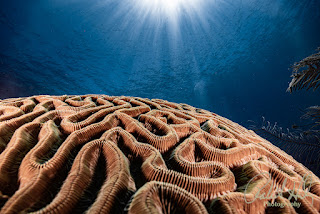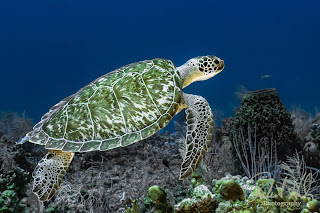Combining Lightroom and Photoshop for Ultimate Underwater Photo Edits
As underwater photographers, capturing the perfect shot below the surface is challenging. The limited light, the particulate-filled water, and the blue-green hues can dull what is otherwise a spectacular scene. That’s where post-processing comes into play—and where combining the powers of Adobe Lightroom and Photoshop can take your underwater images to the next level.
In this post, I’ll explain when and how to use Lightroom and Photoshop for more complex edits, giving you the tools to bring out the true beauty of the underwater world.
When to Use Lightroom for Underwater Photo Editing
1. Color Correction and Basic Exposure Adjustments
One of the biggest challenges in underwater photography is the loss of red light as you descend. Even the most vibrantly colored fish can appear dull and washed out. In Lightroom, you can fix this quickly using the White Balance slider. For example, after diving into a location like Roatan, you might have a shot where the reds are completely muted. By sliding the Temperature slider toward the warmer tones, you can restore the rich reds and oranges that are missing due to water depth.
- Tip: When dealing with deeper dives where colors are more muted, don’t be afraid to experiment with the Tint slider, moving it slightly toward magenta to offset the green cast of the water.
Lightroom also excels at adjusting exposure. Say you’ve photographed a sea turtle, but the image looks too dark because you didn’t use a strobe. A simple boost in the Exposure slider and tweaking the Shadows can bring the turtle out of the murky depths.
2. Batch Editing for Multiple Similar Photos
Let’s say you’ve surfaced from a dive with 100 shots of a vibrant coral reef. You don’t want to manually edit each one—especially if the lighting and conditions are consistent. Lightroom’s Sync Settings feature is a lifesaver. After editing one photo (adjusting exposure, contrast, clarity, etc.), copy those settings and apply them to the rest of your images.
- Tip: If you’ve made lens corrections (a must for some wide-angle underwater lenses), this setting can also be synchronized across multiple images for consistent distortion corrections.
3. Organizing Your Photo Library
The number of photos we take as underwater photographers is mind-blowing, especially on multi-dive trips. Lightroom’s Library module lets you easily organize your pictures by dive site, species, or location. For example, you can create collections for each dive location: one for Roatan, another for the Great Barrier Reef, etc. Within those collections, I use Keywords like “turtle,” “anemone,” or “macro” to quickly locate specific shots when I’m editing later.
When to Bring Photoshop into the Equation
1. Advanced Retouching: Removing Larger Objects
We’ve all been there. You’ve captured the perfect shot of a school of fish, but a random diver’s fin is poking in from the edge of the frame. Lightroom’s Spot Removal tool is excellent for tiny specks of backscatter, but it’s time to move into Photoshop for bigger, more complex retouching.
In Photoshop, using the Clone Stamp Tool or the Patch Tool, you can seamlessly remove that fin while maintaining the texture and lighting of the water. For example, if a distracting buoy line runs through your shot of a whale shark, Photoshop allows you to erase it without leaving behind a trace.
2. Precision Edits for Marine Life
You must often enhance the details when shooting subjects like nudibranchs or seahorses. Lightroom’s global adjustments might not give you the control you need here. This is where Photoshop’s Layer Masks and Selection Tools come into play. After boosting contrast and clarity in Lightroom, send your image to Photoshop to fine-tune the edges of your subject using tools like Select and Mask. You can then isolate your subject and apply specific sharpening only to it, leaving the background untouched.
- Example: When I shot a close-up of a jellyfish, Lightroom helped bring out the color, but Photoshop allowed me to delicately sharpen the edges of the jelly’s tentacles without affecting the water around it.
3. Creative Compositing and Blending
Sometimes, your vision for an image goes beyond what was captured in a single frame. For instance, you might want to combine the vibrant colors of a shallow reef shot with the dramatic lighting of a silhouette from a deeper dive. In Lightroom, you can adjust each image's color tones and exposure, but Photoshop lets you blend these two scenes seamlessly.
- Tip: Use Photoshop’s Layer Blending Modes to combine multiple exposures. I often blend a well-exposed foreground subject (like a diver) with a darker background (like a school of fish) to create a balanced composite.
How to Seamlessly Transfer Photos Between Lightroom and Photoshop
Knowing how to move back and forth between Lightroom and Photoshop is essential to maximize efficiency.
Start in Lightroom:
Import your photos, perform basic edits (color correction, exposure, clarity), right-click the image, and select Edit in Photoshop. This creates a TIFF file, preserving your original RAW edits and allowing you to dive into Photoshop for more detailed work.Edit in Photoshop:
Once in Photoshop, use the power of layers to perform precise retouching, blending, or advanced corrections. Let’s say you’re working on a shot of an eagle ray with some lens flare. You can add a new layer, use the Clone Stamp to remove the flare and keep your original image intact.Sync Back to Lightroom:
After completing your Photoshop edits, simply hit Save (not Save As), and the file will reappear in your Lightroom catalog with all Photoshop changes applied. You can then continue fine-tuning or organizing the image within your Lightroom library.
Specific Examples of Combined Lightroom-Photoshop Edits
1. Removing Stubborn Backscatter
Backscatter is one of the most frustrating aspects of underwater photography. Start in Lightroom by using the Spot Removal Tool for smaller particles, but if the scatter is widespread, open the image in Photoshop. Use the Healing Brush Tool with a soft edge to remove larger clusters of backscatter. For particularly tricky areas, I sometimes use the Dust & Scratches Filter in Photoshop, which smooths out noise without losing sharpness in your subject.
2. Blending Multiple Exposures for Dynamic Results
When shooting both, it's challenging to expose both foreground and background elements perfectly. For example, if you’re shooting a diver framed against a reef, one might be too dark while the other is perfectly lit. After adjusting each image in Lightroom, combine them in Photoshop using Layer Masks. Paint each image's well-exposed sections for an evenly balanced final result.
3. Creating Stunning Sunbursts
Let’s say you’ve captured a sunburst, but it’s not as dramatic as you’d like. Start by tweaking the highlights and whites in Lightroom, then open the image in Photoshop and use the Radial Filter to emphasize the sunburst, adding a bit of lens flare or even enhancing the beams with Dodging and Burning techniques.
Workflow Tips
Non-Destructive Editing: Always use Smart Objects in Photoshop when combining it with Lightroom. This allows you to switch back and forth without losing image quality or needing to start over.
Using Adjustment Layers in Photoshop: Instead of directly editing your image, use Adjustment Layers in Photoshop for things like exposure, levels, and contrast. This way, your edits are easily adjustable, and you can return to Lightroom with complete flexibility.
Conclusion
You can tackle even the most challenging underwater edits by combining Lightroom’s organizational and batch-editing powers with Photoshop’s advanced retouching and compositing tools. With a workflow that leverages the best of both worlds, your underwater photography will capture the beauty you saw and showcase it in its vibrant glory.
Stay Connected
Follow my blog for more tips and tutorials on underwater photography. Let's dive deeper into the art and craft of capturing the marine world!
Subscribe to my blog for more tips and tutorials on underwater photography. Remember to share your processed photos on social media using the hashtag #RobertHerbPhotography. I look forward to reviewing your results.
New Online Training Program
I am excited to announce that I am creating an online training program to teach underwater hobbyists and enthusiasts how to enhance their photos using Adobe Lightroom. If you are interested in this training or need more information, please go to (Underwater Photo Training) or contact me at bob@robertherb.com to express your interest and to be notified about the details and start date of the classes.
Stay tuned and "Follow" for upcoming blogs on underwater photography tips and tricks for more in-depth insights. Please leave your comments and suggestions. Enjoy your diving and shooting experience!
I am eagerly anticipating your valuable feedback and suggestions.
Sincerely,
Bob Herb
|
|





Comments
Post a Comment
Please let me know your comments.